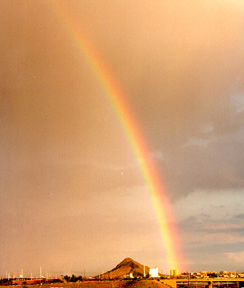

Through the Looking Glass...
White light is composed of all wavelengths of visible light. This means that the waves that make up sunlight and incandescent light are a mixture of all the colors of the spectrum. If we could somehow break up this white light, we may be able to see the various components of that light: the spectrum of colors. As we've seen before, special optical devices called prisms can split white light into its various wavelengths. This can happen because the different colors in the white light respond to the glass in different ways. Blue light tends to bend, or refract, more than the wavelengths corresponding to green, and green light refracts more than the wavelengths corresponding to red. This effect is called dispersion and occurs in all substances which refract light.Our "glass" of water, like the prism, refracts and disperses light. As the sunlight streams through the window and into the water (the glass of the "glass" helps a bit, too), the light is bent (refracted) and broken up (dispersed). When the light reemerges from the other side of the glass of water, it's heading in a slightly different direction from its original path and it's no longer just white light. We see a fantastic spectrum of colors on the floor.
if you've finished the Rainbow Activity
Page authored by the ACEPT W3 Group
Department of Physics and Astronomy, Arizona State University, Tempe, AZ 85287-1504
Copyright © 1995-2000 Arizona Board of Regents. All rights reserved.